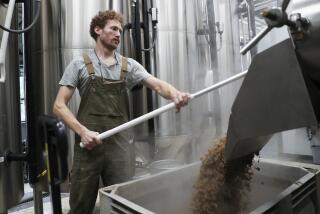Fabulous fizz
OUT to lunch on the first blistering day this year, my red wine-loving consort unexpectedly ordered a Stella Artois with his steak frites. I don’t know if it was the heat or the hops, but I tasted it and immediately thought of how good lager would be in a chilled soup, maybe a good and icy gazpacho-y one. The flavor and the effervescence had great potential.
Usually I only contemplate cooking with beer when the weather is anything but sunny and warm. There’s a reason it’s mostly associated with beef stews, chili and other dishes that need long, slow braising or simmering, not to mention rich cheese sauces and bean or cabbage soup. Beer just seems to signify heartiness.
But I’ve found it actually rivals wine as an ingredient for all seasons. Whether you whisk it into a batter for fried fish or vegetable fritters or just pour it into a steamer for clams or mussels, it imparts a distinctively malted, slightly floral, almost salty-sweet undertone to food. Beers can be fruity, herbal, yeasty, hoppy and more, and those serious flavors harmonize with a surprising array of “real” ingredients.
As with wine, different styles of beer can work differently in different dishes. In some dishes, you can use any old brew, but more often you need to stop and think. While a dark and sturdy stout is superb in a beef or venison stew, it will overwhelm anything ethereally seasonal. The light magic of a Pilsener is perfect with seafood, but it can get swept away by too many herbs and aromatics.
With so many styles of beer out there, taste is the surest guide. A beer with depth and nuance will bring out those same qualities in a sauce or a marinade. The old “one for me, one for the recipe” is a foolproof formula -- of course you have to sample to decide which might be the right one for every dish.
Every type works
Overall, beer works best as a complement rather than a counterpoint to other tastes. More full-bodied types such as porter or dark ale are most suited to dishes with assertive flavors of their own: anything with chiles or garlic or lots of spices, or with any ingredient that stands alone, such as shrimp or sausage. Lighter beers such as lagers and American pale ales are best in dishes that will be served cold, when they can be added at the last minute, or in those with more subtle, even delicate, flavors.
A fruity beer, such as a lambic from Belgium or a California pale ale such as Sierra Nevada, brings out depth in vegetables that are almost sweet, such as braised onions to top a focaccia or add to the filling for a tart. The almost raspberry flavor of the lambic beer is nice in a combination of Vidalia onions, yellow crookneck squash and corn, simmered together with butter until they are as soft and melty as ratatouille; pale ale imparts a tanginess.
Ale is also good for baking because it adds a malty undertone to leavenings such as baking powder and baking soda. Like all dark beers, ales have an affinity for flour, maybe because they are fermented from cereal grains. I use pale ale in hot biscuits flecked with diced jalapenos, with or without Cheddar cheese (cheese and beer are natural companions), but a darker ale would also be good because it can stand up to the jalapenos.
Very light beers -- in color if not calories -- such as Pilseners and other lagers are most suited to dishes with just as much of an airy aspect to them. Cold soup is a natural destination, whether cucumber, potato-leek or even fruit soup such as cherry.
Dark beers can go almost anywhere red wine would, especially in marinades. I like a Mexican dark beer to juice up chicken to be grilled; it harmonizes with lime juice and is not stifled by garlic, cumin and chipotle chiles.
For steaming or boiling shellfish, whether clams or crabs, though, just about any beer will work. You can also steam sausages in nearly any style of beer. In either case, you can simply upend a bottle into a stockpot all by itself or supplement it with aromatics such as garlic, shallots, fresh ginger or jalapenos or other chilies. A little olive oil rounds out the flavors.
A fluid ingredient
Beer has one drawback over wine: It is not a liquid that reduces to something more magical than what it began as. Mostly it cooks away leaving only bitterness. But it has many advantages over wine: When you pour it into a hot pan, over buttery vegetables, you get a terrific audible eruption of fragrance and foam -- the effect is as satisfying as opening a bottle of Champagne. Beer also comes in comparatively small bottles, so you can use as little as you need, and it even functions once it goes flat. In baking in particular, you just need the flavor, not the head.
Beer is literally liquid bread, a food you drink, so it stands to reason it would be such an integral ingredient in its own right. And while most cookbook indexes seem to jump from “beef” to “beets,” in summer there’s a reason to insert beer.
*
Beer- and lime-marinated chicken
Total time: 45 minutes plus marinating time
Servings: 4
1 (12-ounce) bottle dark beer, preferably Mexican
1/2 cup freshly squeezed lime juice
4 cloves garlic, minced
2 canned chipotle chiles in adobo sauce, finely chopped
1 1/2 teaspoons kosher salt
1/2 teaspoon ground cumin
1/2 teaspoon crushed dried oregano, preferably Mexican
1/2 cup peanut oil
1 chicken (2 1/2 to 3 pounds), cut into quarters
1. Combine the beer, lime juice, garlic, chipotles, salt, cumin and oregano and mix well. Stir in the oil. Reserve one-half cup for brushing on the chicken.
2. Place the chicken in a glass or other nonreactive baking dish and pour the marinade over it. Cover and marinate in the refrigerator for at least 1 hour and not more than 4. Return the chicken to room temperature 30 minutes before cooking.
3. Heat the grill. Lay the chicken on the grill, skin side down. Cook, basting occasionally with the reserved marinade, until the juices run clear, about 15 minutes on each side.
Each serving: 431 calories; 41 grams protein; 2 grams carbohydrates; 0 fiber; 27 grams fat; 7 grams saturated fat; 163 mg. cholesterol; 238 mg. sodium.
*
Chilled tomato-beer soup
Total time: 25 minutes, plus 4 hours chilling
Servings: 8
Note: Green garlic is available in farmers markets. You may substitute blanched, chopped regular garlic.
4 cups peeled, seeded and diced very ripe tomatoes (about 10 medium)
1 cucumber, peeled, seeded and chopped
2 green onions, trimmed and chopped
2 teaspoons chopped green garlic
1 (12-ounce) bottle very cold Pilsener or lager
1 teaspoon sea salt, or to taste
Freshly ground black pepper
2 tablespoons chopped chives
1. Combine the tomatoes, cucumber, green onions and garlic in a blender and process until smooth.
2. Pour the mixture into a bowl. Cover and chill at least 4 hours.
3. Just before serving, stir in the beer. Season with salt and pepper. Garnish with the chives and serve at once.
Each serving: 34 calories; 1 gram protein; 5 grams carbohydrates; 1 gram fiber; 0 fat; 0 saturated fat; 0 cholesterol; 295 mg. sodium.
*
Jalapeno biscuits
Total time: 35 minutes
Servings: Makes 12 biscuits
2 cups flour
1 teaspoon baking powder
1 teaspoon baking soda
1 teaspoon kosher salt
2 large fresh jalapenos, seeded and chopped
1/2 cup cold unsalted butter, cut into thin slices
About 1/2 cup cold California pale ale or amber ale
1 cup grated sharp Cheddar
Softened butter for serving
1. Heat the oven to 425 degrees. Lightly grease a large baking sheet.
2. Combine the flour, baking powder, baking soda and salt in mixing bowl. Stir in the jalapenos. Using a pastry blender or 2 knives, cut in the cold butter until the mixture resembles coarse crumbs. Add the ale a few tablespoons at a time and stir the dough until it clings together in a ball. Dough should be slightly sticky but still easy to handle. Knead in the cheese. Don’t over-mix.
3. Lightly dust a work surface with flour. Turn the dough out and knead a couple of times. Pat the dough out into a round about one-half inch thick. Using a cookie cutter or small glass, cut out into rounds about 2 1/2 inches in diameter. Place on the baking sheet.
4. Pull together the dough scraps and pat out again, then cut more biscuits. Bake 14 to 15 minutes, or until risen and lightly browned. Serve hot with butter.
Each biscuit: 149 calories; 2 grams protein; 16 grams carbohydrates; 1 gram fiber; 8 grams fat; 5 grams saturated fat; 20 mg. cholesterol; 342 mg. sodium.
*
Beer-braised summer vegetables
Total time: About 50 minutes
Servings: 4
4 tablespoons unsalted butter
1 large Vidalia or other sweet onion, peeled, quartered and thinly sliced
1 red bell pepper, cored, seeded and thinly sliced
3/4 teaspoon coarse sea salt
2 medium yellow crookneck squash (not zucchini), trimmed, halved lengthwise and thinly sliced
1/2 cup Belgian-style lambic beer or California pale ale
1 1/2 cups fresh or frozen corn
kernels (about 2 cobs)
Freshly ground pepper
1. Melt the butter in a large, deep saute pan over medium heat. Add the onion and pepper and toss to coat. Sprinkle lavishly with salt and saute 7 to 10 minutes, until soft. Stir in the squash and cook 2 to 3 minutes, until it begins to soften.
2. Stir in the beer. Bring the mixture to a simmer, then reduce the heat, cover the pan and cook, stirring occasionally, until the vegetables are soft and almost melting together, about 15 minutes. Stir in the corn kernels and continue cooking until tender, about 5 minutes longer. Season with pepper to taste and serve.
Each serving: 203 calories; 4 grams protein; 21 grams carbohydrates; 4 grams fiber; 12 grams fat; 7 grams saturated fat; 30 mg. cholesterol; 446 mg. sodium.


